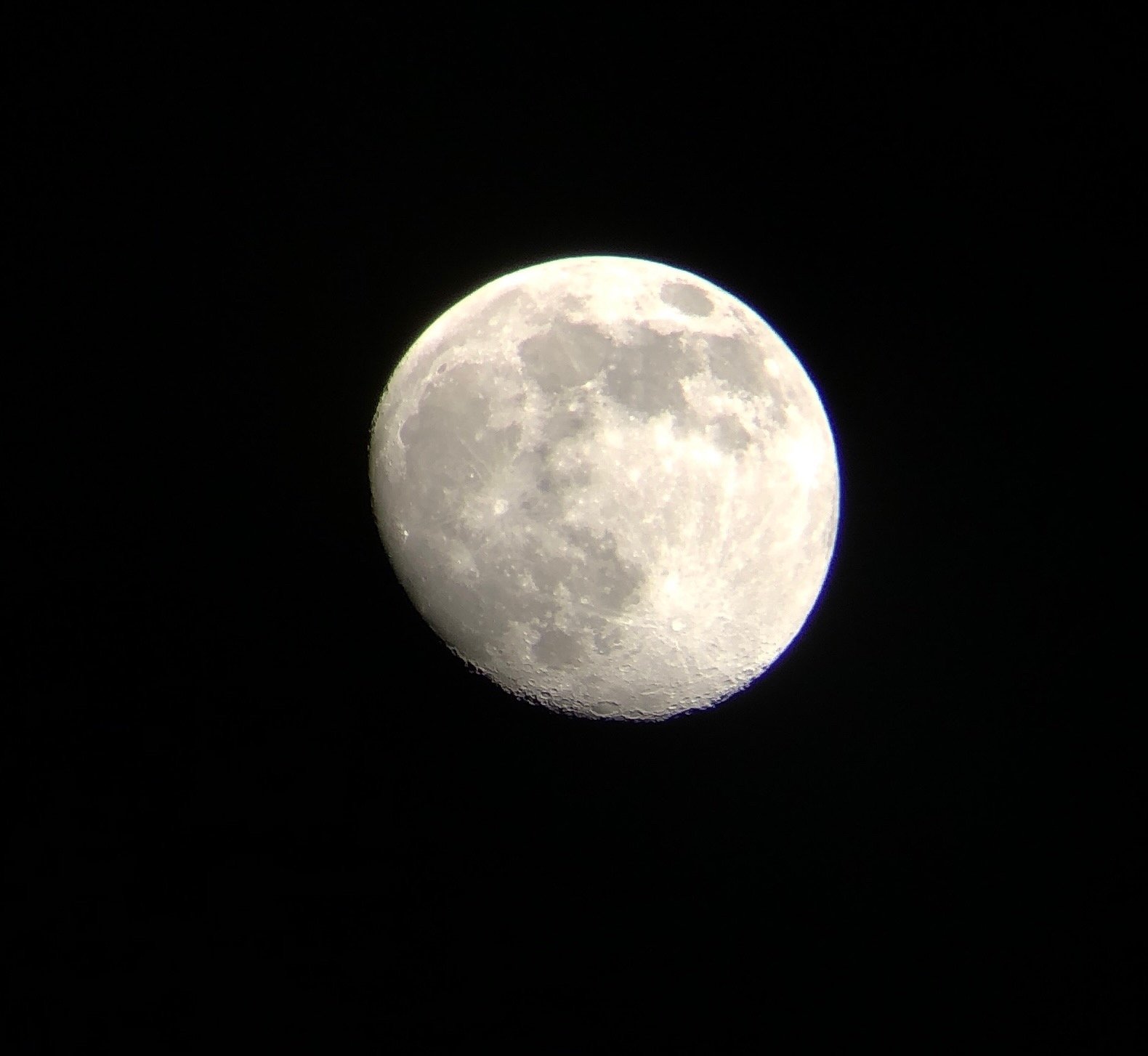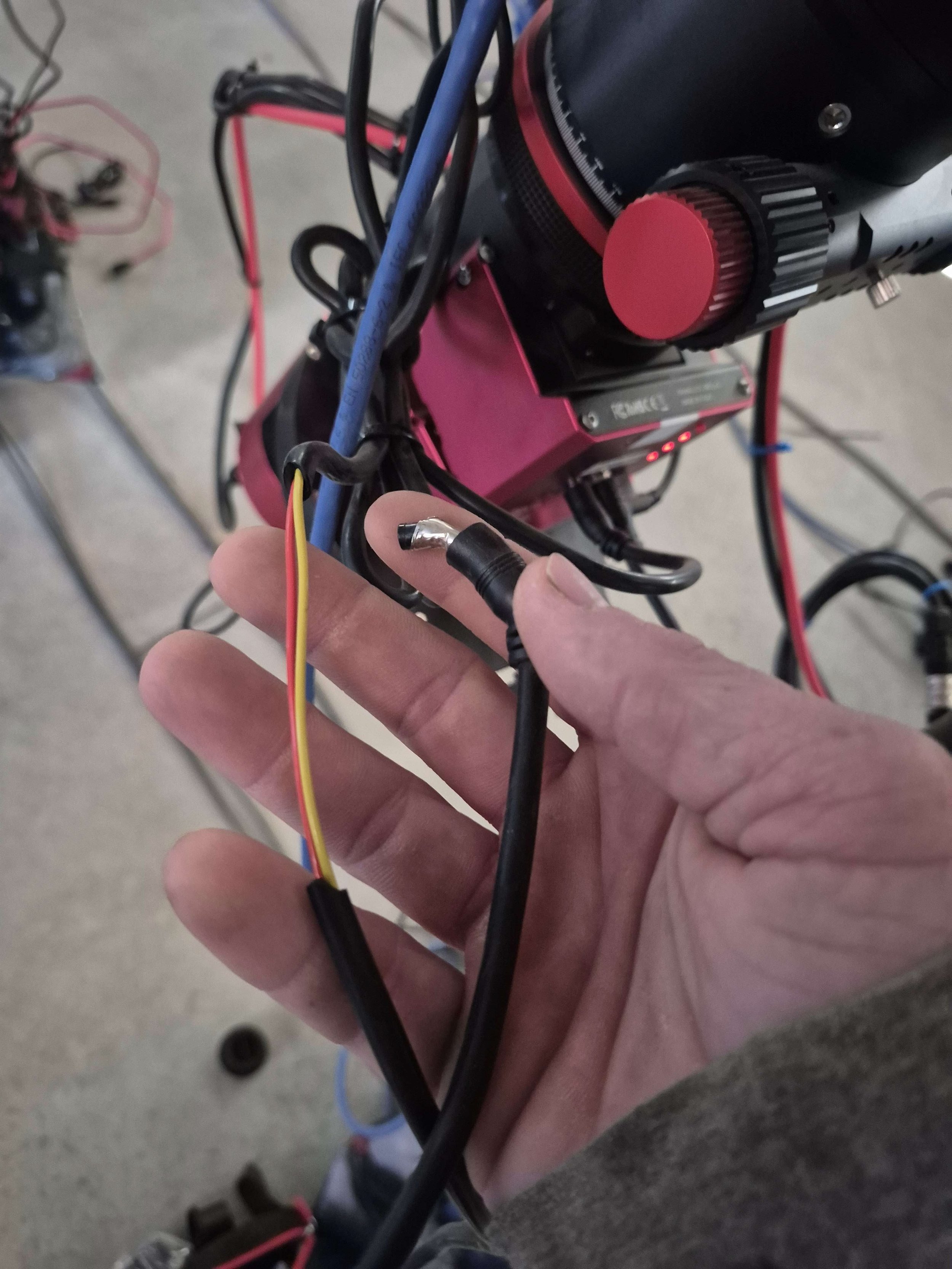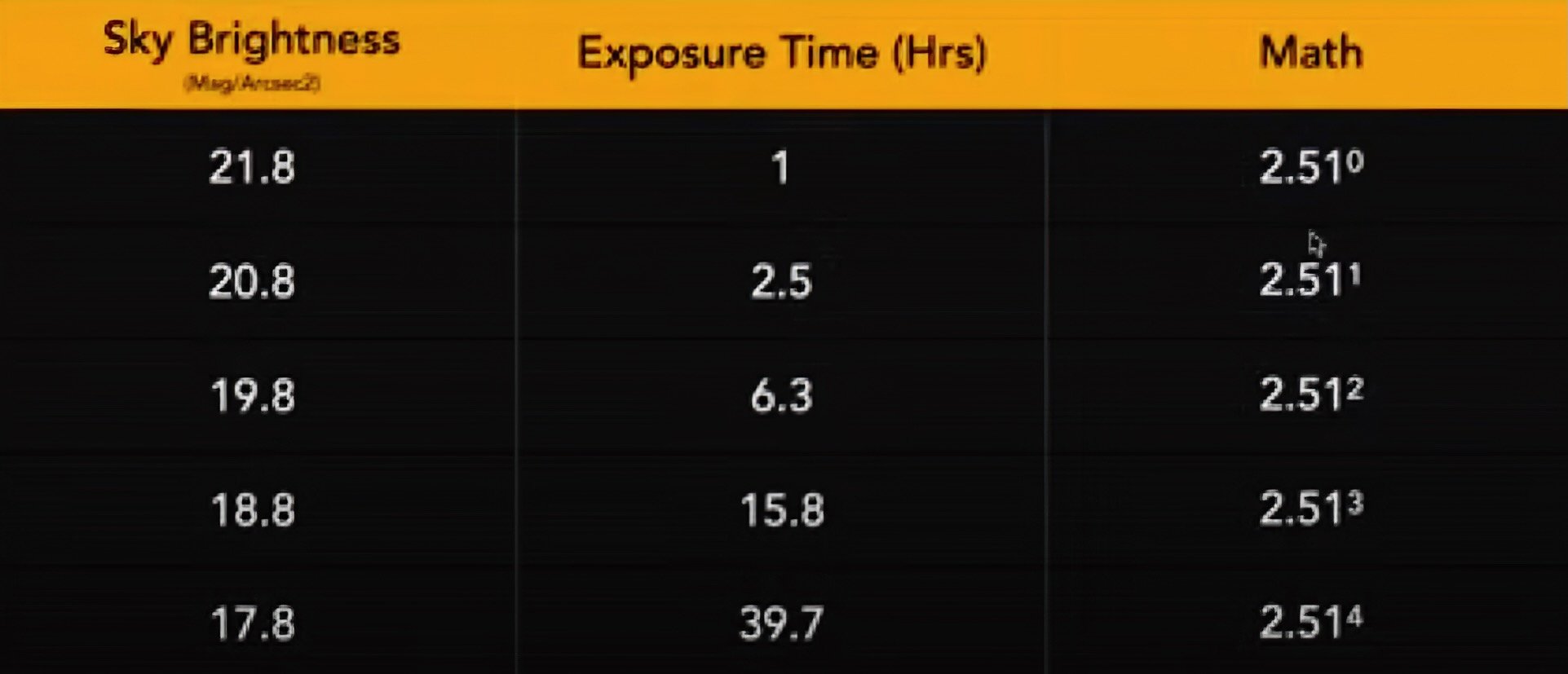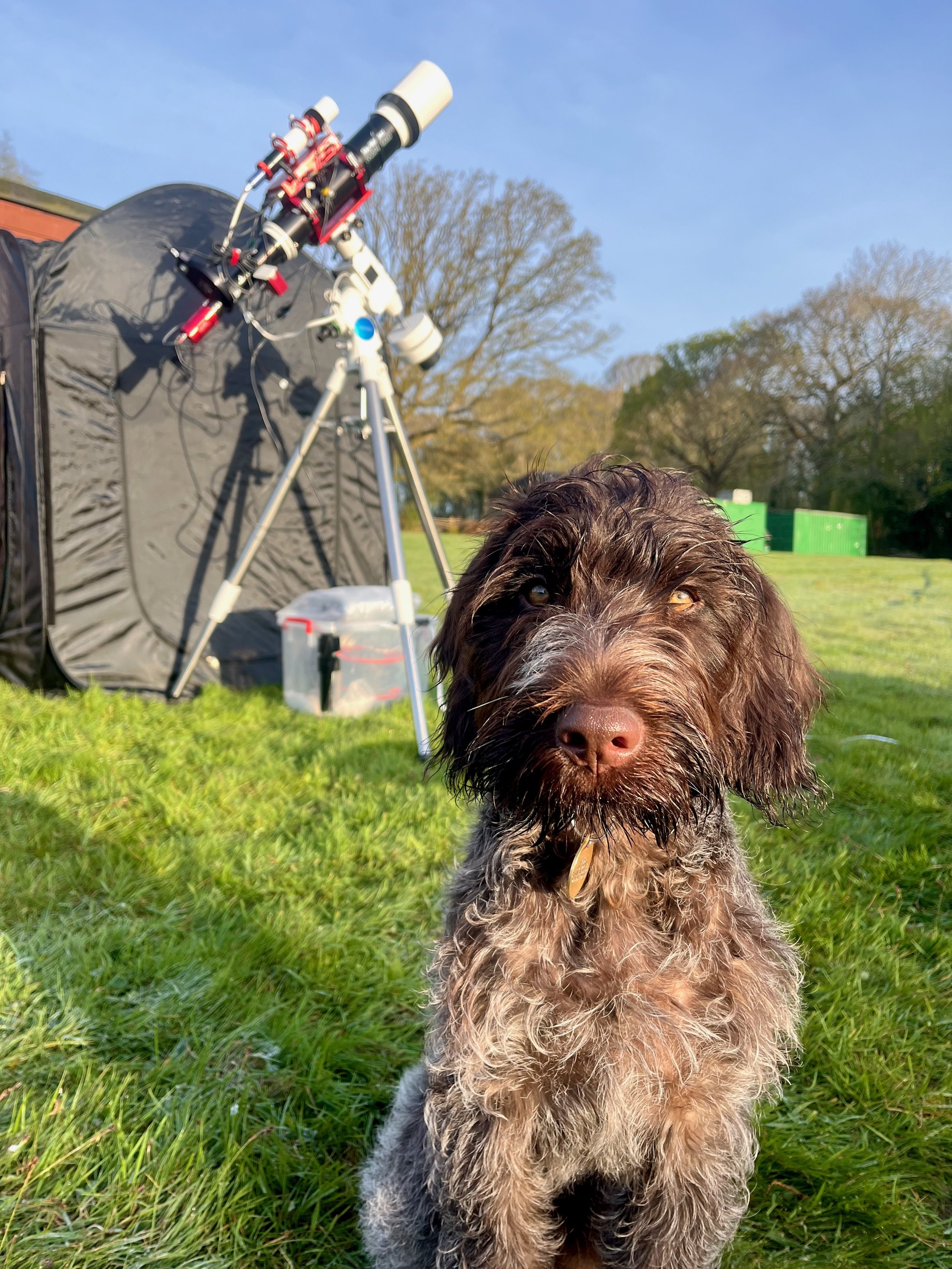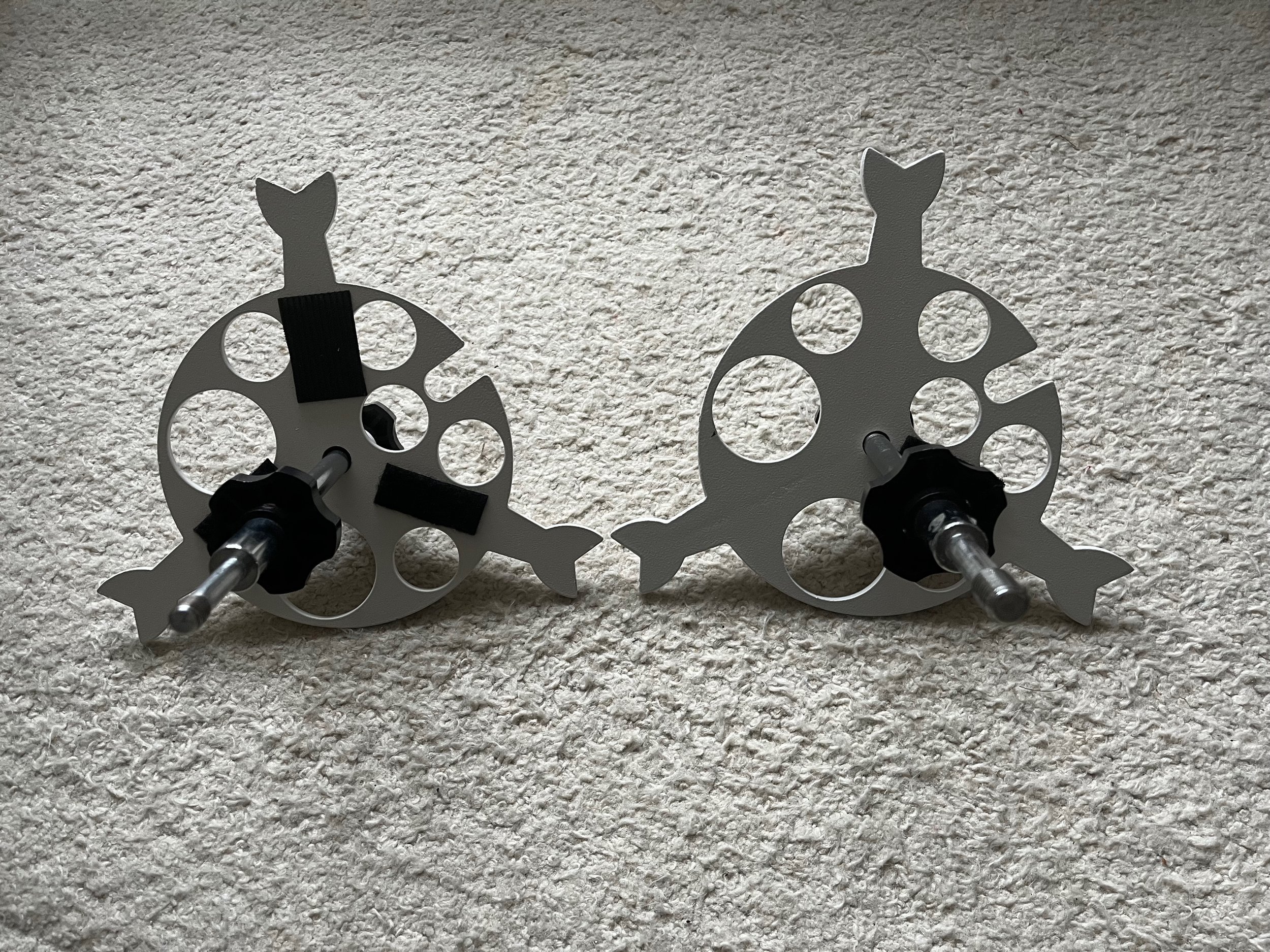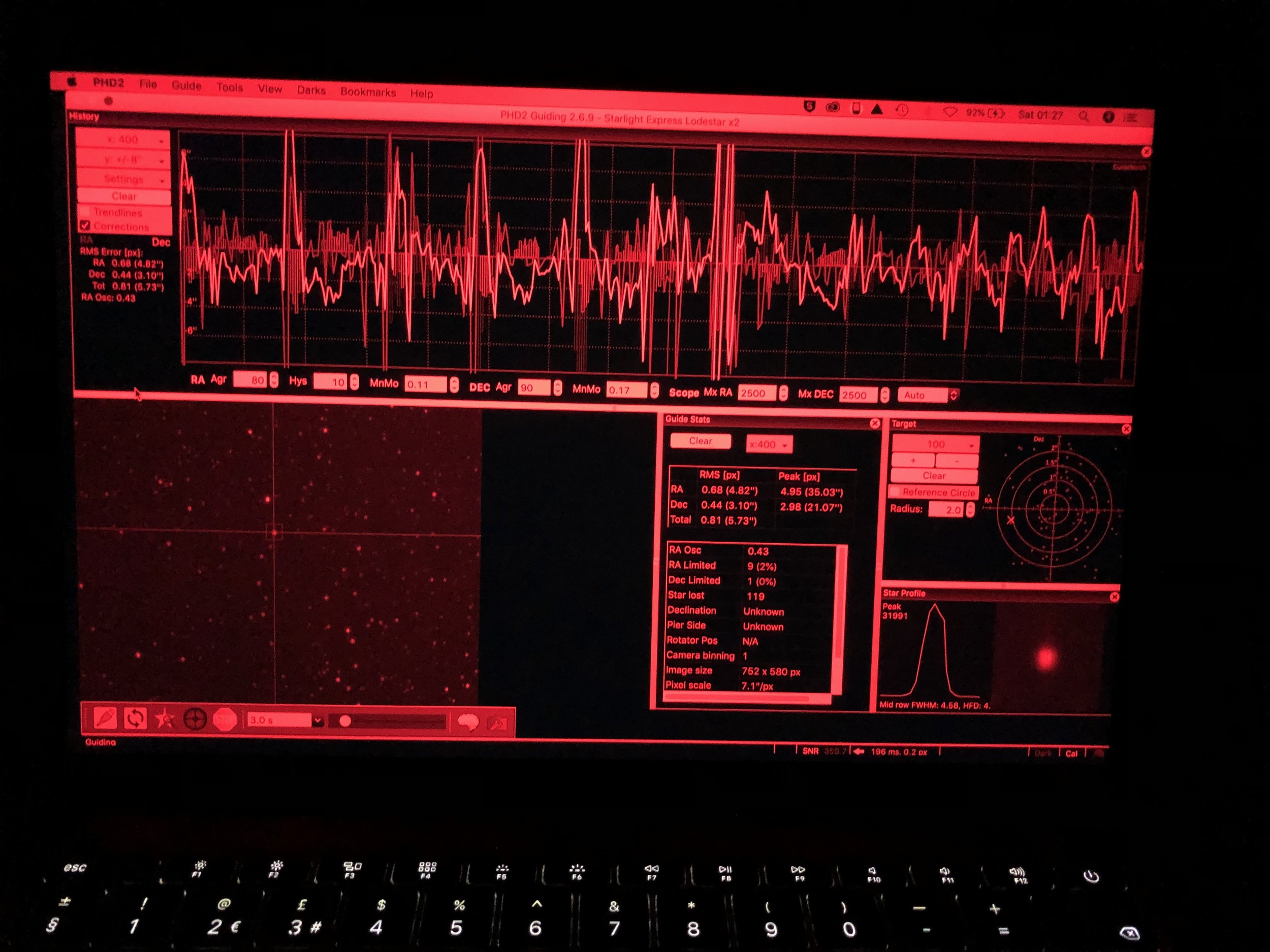
Blog - muddling through
Welcome to the least read blog in the solar system! I will try to make this ‘warts and all’. Astrophotography is full of disasters, disappointments and bungling errors. But it’s still worth it.

July 6th 2025
First Light
My 250mm Redcat 51 UK rig is now up and runnng. I need a lot more exposures on The Cygnus Loop below, but here is ‘first light’, the result of 6 hours over two night in Bortle 4 East Sussex at a time of year when there is no astronomical darkness. I have to iron out some issues with the auto focus, but this is shaping up nicely so far I think. Going wider than the Texas telescope has renewed my desire to head out under the starts in the UK.

June 10th 2025
Tilt eliminated!
I can’t recommend this product highly enough. The Gerd Neumann tilt adjuster enables you to tweak the tilt from the side without the laborious process of having to disassemble the optical chain each iteration of testing and checking. See below my ‘before’ and ‘after’ results after I used it to dial in my ASI2600MM Pro camera with a Redcat 51. Adjusting tilt is definitely not my strong point, but even I could get a near perfect result with this.

May 26th 2025
Cloud, clouds and more clouds
Having set up my remote telescope in Texas, I am now feeling the same weather-related frustrations as I experienced in the UK. April and May are rainy season months, meaning the pristine skies are obscured by cloud cover and the observatory roof remains firmly closed. I have 26 hours of exposures on the Eagle nebula so far and here is the work in progress below. I need to add more data to this, so for now it’s a frustrating waiting game for clear skies…

May 16th 2025
Where it all began
This is the image that began it all in April 2020 during Covid lockdown. Whilst in the back garden with my daughter Zoe, I held an iPhone over the eyepiece of a small Celestron 400mm refractor costing less than £100. That’s how we took this picture of the moon. It’s a pretty poor image, but that didn’t matter… it was our image. It was my gateway drug into astrophotography and changed my life.

May 15th 2025
Messier 106
I finally got awarded a ‘Top Pick’ for a deep sky object on the Astrobin website. These recognitions have to be nominated and voted for by various assigned judges. My only previous Top Pick was for a wide field image of the aurora borealis. Here is the target, Messier 106. It’s far from being one of the most dramatic images I have taken and is not my favourite galaxy, but I am very happy it got picked…

February 12th 2025
Breaking ‘the rules’ - colour saturation
I generally don’t like super bright colours in astro images, as they tend to detract from the spacey feel. Usually less is more and going overboard with them is frowned upon by many in the astro-community. But with my Hubble Palette image of the California Nebula I have gone for some really strong reds, yellows. Somehow this target demands vibrancy which seems to enhance some of the features in the billowing dust and create a striking impression. What do you think? Too much? In the end, there are no rules. Except to enjoy the hobby.

February 11th 2025
Remote Imaging - disaster lurks
One of the perils of remote imaging is that you can’t get up close and personal with your telescope to see what dangers lurk. My webcam’s angle prevents close inspection of what is happening to the cables and on this occasion disaster struck when the power line to the mount became wrapped around the pier. A meridian flip snapped the cable and damaged the power input port to the mount, but thankfully not so badly that the port won’t function. I now have a new cable running into the mount from a power brick rather than the on board mini computer, so hopefully this won’t happen again.
A power brick is now strapped onto the side of the pier, at the top left of this image.

January 20th 2025
‘If you build it, they will come’
Starfront Remote Observatories in Texas is booming. Six buildings are now full of scopes with a further two filling quickly. Among the forest of telescopes I spotted my own. It’ll never feel lonely…
Above: My telescope is almost hidden at the back in this shot. The scene is brightly lit by a near full moon.
Below: Here’s the completed version of the Horsehead and Flame Nebulas mentioned in my previous blog post. See home page link for details.

December 12th 2024
Work in progress
Here is my latest project - a work in progress. I am feeling excited about this one. This is the Horsehead and Flame nebula and the data below is purely the red and Ha filters combined. This will be in full colour, but think it looks quite cool in monochrome, so here it is…

December 3rd 2024
First Light from Texas
Here is my first image from Texas. The quality of the sub frames under these darks skies is amazing - a single frame is the equivalent of a stack containing dozens of frames gathered back in London. The data is so much easier to work with, after usually having to push everything to the limit. This is the Rosette Nebula, off the shoulder of Orion…
This table below shows how under darker skies you need fewer sub frames. I think an hour under Texas skies is the equivalent of around 20 hours from my back garden in London. And even then, the quality will never match that obtained under Bortle 1/2 skies.

November 18th 2024
Remote telescope - gradually coming together
The Texas project is at last moving forwards at pace now. It’s been a bumpy and sometimes stressful process getting this far…
Ordering up more than 25 parts to be shipped from California and Miami to the wilderness of central Texas felt like a risky endeavour, although it worked out perfectly with nothing missing.
Now the rig is built, installing software and calibrating the hardware is tricky without being able to physically touch it. The technicians at Starfront Observatories are highly skilled and have saved the day helping dial things in. But they are understandably very busy because there are around 100 set-ups there. It’s frustrating waiting and relying on others to tweak my rig when I am used to being hands-on and doing it myself. As ever with astrophotography it’s all about trying to stay patient.
I still have the auto-focus and guiding to dial in tonight - fingers crossed that goes well. .
Anyway, beneath last night’s full moon, here is a webcam shot. You can just make out Orion, lower right, among the stars. And with the roof closed, a further shot of the set-up which is almost identical to the one here in the UK.

November 12th 2024
Remote telescope - I am going over to the dark side
Nothing can beat sitting under the stars, hands-on with a telescope, taking images of deep space. But, opportunities to do this in the UK are rare, due to our persistent cloud cover. So I’ve decided it’s time to go over to the dark side and install a remote telescope 5,000 miles away.
I live in light polluted London where I try to battle our poor conditions with narrowband filters. I have driven out of the city to darker skies on countless occasions. But there is one problem that filters and long drives can’t solve… clouds. And I’ve finally had enough. I’ve spent too many winters where long dark nights, full of potential, are cursed by a thick blanket for weeks on end. And it seems that when the clouds do finally clear, the moon grabs the opportunity to make an appearance and wash out the sky with its bright light.
So I have decided to replicate my UK telescope piece-for-piece permanently at Starfront Observatories in the heart of Texas. This scope is being assembled beneath Bortle 1 dark skies and where two out of every three nights are clear. I will remotely operate it from London. I hope it works or, as they say in Texas, I will be ‘all hat and no cattle’.
Is it ‘cheating’ to build a telescope in such a favourable location? Well, I have put in my fair share of hard hours and experienced enough disappointments with adverse UK weather conditions. And I guess I will continue to do so, because it will be business as usual with my UK set-up. But to create more opportunities to enjoy astrophotography, this is the only way to go. I could of course move permanently to a teepee in the Atacama desert, but my family don’t seem to be up for that. Inconsiderate!
Now I just need to find a way of getting rid of that moon.
Image copyright Trevor Jones/astrobackyard
Below - a typical cloud cover map of the UK. Looks like there is a 5-minute gap in the clouds in Cornwall. Ouick - head west!
Howdy, Texas!

November 1st 2024
Lazy astrophotography
Sometimes I will drive for hours, physically hauling ten boxes of cumbersome kit to set up and take a photo. But just occasionally all that’s required is three paces from my bed to the nearest window… or even no paces at all. So here are three lazy images from my bedroom. In the first you can see noctilucent clouds - upper atmosphere clouds of ice crystals that appear at twilight in the summer. These are the highest clouds you will see.
Next is the moon with Venus close by. And finally you can see comet Tsuchinshan-ATLAS imaged from my sick bed when I was recovering from a cold. Lots of light pollution in there, but I was just happy that I could register its image.
Okay, so these aren’t the greatest astro-images and maybe my neighbours think I am a creepy peeing tom spying on them rather than the sky, but I will be keeping my eye out for more bone-idle bonuses.

July 2nd 2024
Hubble Palette
I just added another Hubble Palette image to my collection. Like Hubble’s famous Pillars of Creation picture, these have a classic traffic light colour scheme. Red is assigned to the Sulphur gas and blue to oxygen - real colours. But hydrogen is also red and needs to be distinct from the red sulphur, so that gets assigned to green. The result is ‘false colour’ but it’s kind of beautiful and the gases are neatly separated. That said, I am definitely ready to move onto something more ‘spacey’ now, closer to how to eye would see it.

June 29th 2024
Oldies become new
I still have my copy of Astronomy in Colour that I got hold of when I was aged 12. It was full of state-of-the-art colour images of galaxies, nebulas and much more. They were shot in the 70s by the world’s best imagers, all on film of course which must have been incredibly challenging. I loved them. I have imaged a few of these myself and you can see the comparisons above. Interesting to see how much more resolution can be achieved today with a backyard amateur refractor and digital camera.

June 5th 2024
Competitive Cravings
For a few years now I have been a regular user of the Astrobin website run by a smart guy called Salvatore Iovene. It’s the go-to place for keen astrophotographers to post images with all-important ‘technical cards’ that give full details of how their pictures were taken. The site has a round 50,000 users from all over the world and is hugely popular.
There is a large, well organised team of volunteers who weed out images to be given one of three accolades:
Nominated for a Top Pick
Top Pick
Image of the Day
There are various layers to the ‘judging’ and Salvatore seems to have figured out, let’s say, the least bad system, despite various astrophotographers on the forums getting their knickers in a twist about its fairness.
the process is described as ‘not a competition’, but this reminds me of my bike racing days where certain events were promoted by organisers as being ‘not a race’, even though each rider was given a timing chip and their finishing times were posted online. You can imaging how that one played out.
Bike racing tapped into an intensely competitive side to my personality that I think I inherited from my father. I’ve now left the sport behind and one of the great things about astrophotography is that it’s not about competing, except maybe with yourself. Or it should be.
My problem is… I just can’t help myself. There is a dopamine rush with recognition on Astrobin. Picking up nominations and awards there is not easy. The standard is high and the awards feel like hard won recognition for pushing through the learning curve and bouncing back from the inevitable disasters. I’ve picked up seven accolades there so far (images above), but I think just recently I’ve been sucked into the abyss, becoming too preoccupied with whether my images will be recognised on the site.
I don’t want this to spoil the immense pleasure I get from the hobby. So moving forwards, note to self: be more chilled about Astrobin, even if you can’t yet bring yourself to opt out of the ‘competition’.

Perfectly Pink Aurora Borealis
On Friday 10th May there was an incredible display of the Aurora Borealis, or Northern Lights. This is normally only visible in the much higher latitudes of Scotland and Scandinavia for example. But here at a relatively lowly 51 degrees north it was a stunning one in 50-year event.
So often, there is promise of an aurora at this latitude, following an outburst of solar activity, but it fails to deliver. So I nearly opted to collapse into bed that night. Due to the prediction that it would be a G4 event - the second highest - I decided to give it a go and headed out to a regular dark spot at a field in Kent.
Initially the pink aurora colour was quite dispersed when I looked at my view finder screen. I actually thought there was an issue with the white balance and camera settings. But then the colours became clearly visible to the naked eye. This was in fact a G5 rating - the highest - and unbelievably spectacular.
After so many cloudy nights recently, this one was completely clear and even the sliver of moon kept a low profile on the horizon. After so many knock-backs the skies delivered a night I will never forget.
I took the image below, which was awarded ‘Top Pick’ on the Astobin website. I also made a time lapse which is on the home page.
It’s scary to think how easily I might have missed this. Social media and the Press all went crazy with images of the event which would have been gut wrenching to see, had I not driven for an hour and a half into the countryside and taken my own. I think I would have hidden in a cave somewhere until everything quietened down.
May 15th 2024

Clouds… clouds… and a loyal new assistant
I have never known such a sustained period of cloudy skies - it has lasted for several months, right through the autumn and winter, wasting so many long nights of darkness. I have only been able to complete one image since early January. The air has been warmer and heavier with moisture. Climate change must surely be a factor here? I’ve really missed being out under the stars.
Anyway, the good news is that this month there was finally a clear night and I managed to sleep under the stars with new my astro-companion Cosmo. He’s a Korthals Griffon gun dog, but he won’t be hunting game, he’ll be star gazing. He was so well behaved on our first outing and I loved his his gentle snoring beside me in the tent. Astrophotography has always been a lone pursuit for me, but no longer. Galaxy NGC2403 was our first co-production and is posted on the home page.
Being a pointer, can I teach him to point to the pole star?
April 26, 2024

January 24th, 2023
Country Life
‘Town Mouse’ from Country Life magazine paid a visit to my home in south London when I happened to have my telescope working away in the back garden. I didn’t realise it was going to result in a mention in the publication…

September 29th, 2023
PixInsight v Photoshop
I am learning how to use the PixInsight astrophotography processing software and have done a few comparisons. I've been using Photoshop solidly for a few years now and have spent literally hundreds of hours with it. Let’s see a a side by side comparison of identical data from my telescope processed in PS and PI, bearing in mind I am a complete rookie with PI. Here is an open cluster (Pleiades), nebula (Elephant Trunk) and galaxy (M51) to compare. It's all a matter of personal preference of course, but I like all three PI images best. I have to admit I was intimidated by PI due to it's notoriously steep learning curve. But the online tutorials by Luke Newbould linked below have been so clear and useful it has been fun so far. I am definitely a PI convert but perhaps ideally it should be combined effectively PS. It's not a simple case of one program being good and the other bad - they are both great - but PI nudges it for me. One key difference is that my images can seem waxy with Photoshop, but are dusty with PixInsight and have a crisper resolution. Ultimately I think the best way forward is to combine the two software packages.

September 24th, 2023
Could I really have been that stupid? er, yes
Even though I have lost count of the number of nights I’ve set up my telescope, I am not immune to making idiotic mistakes. Last week I travelled out of town to a dark site, as there was a rare break in the clouds. This involved loading the car, fighting through aggressive London traffic and carrying ten boxes into a field…. only to discover I had packed the wrong spreader for the tripod legs I had brought. You can see from this photo how this might have happened. Whilst they are not interchangeable, these two look almost identical. Well, that’s my excuse anyway.
Spot the difference

August 27th, 2023
Milky Way Timelapse
This week I completed my first Milky Way time-lapse sequence. It’s completely new to me, so the processing was pretty time-consuming with a steep learning curve. However, there are so many great tutorials on YouTube for learning how to do this and they saw me through. Now I have a workflow in place for next time.
I think my framing of the Milky Way could have been better, but maybe the final result is okay for a first attempt. The camera was pointing directly upwards at the Cygnus region overhead.
There are so many excellent tutorials online that I won’t give a blow by blow account of the process, but here are the settings that worked for me using a full-frame mirrorless camera (Canon EOS Ra).
I shot between four and five hours worth of individual 30” frames which seems like a long exposure when you aren’t using a tracker, but at 15mm focal length this turned out to be fine. As a guide I stuck to the ‘500 Rule’ where 500 divided by the focal length gives you the maximum shutter speed to avoid star trails. It’s not a definitive guide, but worked well for me.
The aperture was set at f/2.8 and I bumped up the ISO to 6400 to grab as much light as possible. The video runs at 24 frames per second.
When it came to processing, I used Camera Raw to adjust a master frame and copy its settings to the rest. I edited the video in Photoshop. Whilst it is best for stills pictures, Photoshop is fine for a short time-lapse sequence, for example with just three shots. It allows good image control and ‘Ken Burns’ panning and zooming to create dynamism. If you are already practised at using Photoshop for stills you have a head start with a familiar workspace. I can also recommend a neat piece of software called TLDF to eliminate flash frames.
The frames were shot at a super-dark Class 2 Bortle site on Canada’s Vancouver Island with no moon. The skies above this forest location were pristine and absolutely beautiful. I persuaded my wife Alixe to join me, even though this required rough sleeping on the reclined seats of a tiny car. She loved it so much she came back for another two nights. Sharing the night sky with someone you love is special.
There are more time-lapses from this location to come when I have had time to process them.
Thanks to musician Alexander Hawkins for providing an ambient track for this sequence. His links can be found in the ‘time-lapse’ section of this website.

June 18th, 2023
Elephant Trunk
I finally finished my Elephant Trunk nebula. This was mostly shot in my light-polluted London garden during a period of zero astronomical darkness, but I did spend a couple of nights in a Bortle 4 field just out of town to grab some frames of the very weak oxygen and sulphur data in this target.
This is actually my fourth attempt at IC1396 because I have never been happy with the results before. It was the first narrowband target I ever attempted, so here is the latest version with my attempt from August 2020 when I began.
The 2020 version looks poor, but I really loved it. I was just amazed that it was possible to capture something like this.
June 2023
August 2020
Below is my 2023 guiding graph showing the accuracy of the tracking. The red one from 2020 looks pretty horrific!
RMS error: 0.32
RMS error: 5.73

June 16th, 2023
Starry Surprise
The night sky is full of surprises. Admittedly, this is often because I am so preoccupied with shooting my target object that I don’t check what other visual treats are in store. Here’s one that took me by surprise. I was just about to pack up the telescope at 3.57am when Jupiter appeared, chasing the crescent Moon across the dawn horizon. An unexpected moment of beauty.

June 11th, 2023
Clouds
Clouds are the enemy of the astrophotographer. On a trip to the West Highlands of Scotland, they refused to budge and reveal the night sky. The only option was to film the clouds themselves. So maybe this one shouldn’t be on an astrophotography website? Although this might be a totally unconvincing justification, you can just see Venus making an appearance top left in the final few seconds!

June 7th, 2023
Gazing Upwards
Telescope technology has developed to the point where even an amateur backyard rig can be programmed to carry out an entire session with full automation - grabbing sub-frames, changing filters, focusing, meridian flipping and re-framing. All while you sleep.
Okay, sometimes you really need to sleep. But otherwise? Automated or remote sessions can mean you miss out on one of the great joys of astrophotography. It’s not all about grabbing those sub-frames. It’s also about looking up in wonderment.
Once my telescope is up and running through its automated session, I don’t want to sleep. This is the moment I can finally relax, crack open a can of beer and gaze upwards. After a few minutes my eyes adjust to the darkness and things begin to show themselves… the silvery path of the Milky Way. Magnificent Orion, manspreading across the southern sky. Sparkling Pleiades. A meteor, streaking like a firework. I once saw Venus, framed by noctilucent clouds in the warm glow of a nearly-risen sun, lining up with Mars, Jupiter and Saturn to reveal the planetary plane of the solar system. Adding to the drama, the super-bright International Space Station rose above the horizon and suddenly popped out of sight as it passed into the shadow of the Earth.
Often I just gaze upwards, unthinking. But the night sky can also provoke deep thoughts and questions about who we are, where we come from and of course the big one… are we alone? Much better than sleeping.
“Remember to look up at the stars and not down at your feet. Try to make sense of what you see and wonder about what makes the universe exist. Be curious” - Prof Stephen Hawking

June 5th, 2023
No astronomical darkness - what can we do?
Where I live in South London, at around 51 degrees north, there are a few weeks from mid-May to the end of August when there is no ‘astronomical darkness’. Sure, it gets ‘dark’ as most people would describe it, but from the astrophotographer’s point of view the sun doesn’t go far enough below the horizon for there to be proper darkness.
So should I pack up the kit and do something else? I just can’t face the idea of doing no astrophotography for several weeks. So here’s my experiment which is a work in progress.
With no astronomical darkness and heavy Bortle 8 light pollution in my back garden, I am trying to put together an image of The Elephant Trunk Nebula (IC1396). I can only get around two hours worth of data in a night, but I will just keep at it, hoping that I can build up something I am happy with.
Here’s the result so far. This is just the Hydrogen-alpha data with 72 frames of five minutes duration. The total exposure is six hours. I replaced my 12nm narrowband filters with narrower 3nm ones which work a lot better blocking out the light pollution. I will update on this when the moon allows for more progress where I can add Oxygen, Sulphur and colour.
Assisting me with my IC1396 experiment is Caspar astro-cat, pictured here on the garden wall contemplating the infinite expanse of the cosmos under a full moon.







